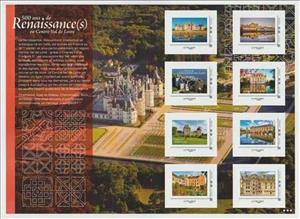Mini Sheet: 500th Anniversary of the Renaissance (France 2019)
500th Anniversary of the Renaissance (France 2019)
12 July (France ) within release Collector : 500 years Renaissance(s) goes into circulation Mini Sheet 500th Anniversary of the Renaissance face value 8*Lettre No Face Value
| Mini Sheet 500th Anniversary of the Renaissance in catalogues | |
|---|---|
| Colnect codes: | Col: FR COL-2019-01 |
Mini Sheet is horizontal format.
Castles of Chambord, Amboise, Chaumont-sur-Loire, Azay-lr-Rideau, Valençay, Chenonceau, Clos-Lucé and BloisAlso in the issue Collector : 500 years Renaissance(s):
- Mini Sheet - 500th Anniversary of the Renaissance face value 8*Lettre;
- Stamp - 500 years French Renaissance face value Lettre;
- Stamp - 500 years French Renaissance face value Lettre;
- Stamp - 500 years French Renaissance face value Lettre;
- Stamp - 500 years French Renaissance face value Lettre;
- Stamp - 500 years French Renaissance face value Lettre;
- Stamp - 500 years French Renaissance face value Lettre;
- Stamp - 500 years French Renaissance face value Lettre;
- Stamp - 500 years French Renaissance face value Lettre;
Mini Sheet 500th Anniversary of the Renaissance it reflects the thematic directions:
An anniversary is the date on which an event took place or an institution was founded in a previous year, and may also refer to the commemoration or celebration of that event. For example, the first event is the initial occurrence or, if planned, the inaugural of the event. One year later would be the first anniversary of that event. The word was first used for Catholic feasts to commemorate saints. Most countries celebrate national anniversaries, typically called national days. These could be the date of independence of the nation or the adoption of a new constitution or form of government. The important dates in a sitting monarch's reign may also be commemorated, an event often referred to as a "Jubilee".
Architecture (Latin architectura, from the Greek ἀρχιτέκτων arkhitekton "architect", from ἀρχι- "chief" and τέκτων "builder") is both the process and the product of planning, designing, and constructing buildings and other physical structures. Architectural works, in the material form of buildings, are often perceived as cultural symbols and as works of art. Historical civilizations are often identified with their surviving architectural achievements.
A building or edifice is a structure with a roof and walls standing more or less permanently in one place, such as a house or factory. Buildings come in a variety of sizes, shapes and functions, and have been adapted throughout history for a wide number of factors, from building materials available, to weather conditions, to land prices, ground conditions, specific uses and aesthetic reasons. Buildings serve several needs of society – primarily as shelter from weather, security, living space, privacy, to store belongings, and to comfortably live and work. A building as a shelter represents a physical division of the human habitat (a place of comfort and safety) and the outside (a place that at times may be harsh and harmful).
A castle (from Latin: castellum) is a type of fortified structure built in Europe and the Middle East during the Middle Ages by European nobility. Scholars debate the scope of the word castle, but usually consider it to be the private fortified residence of a lord or noble. This is distinct from a palace, which is not fortified; from a fortress, which was not always a residence for nobility; and from a fortified settlement, which was a public defence – though there are many similarities among these types of construction. Usage of the term has varied over time and has been applied to structures as diverse as hill forts and country houses. Over the approximately 900 years that castles were built, they took on a great many forms with many different features, although some, such as curtain walls and arrowslits, were commonplace.
A landscape is the visible features of an area of land, its landforms and how they integrate with natural or man-made features. A landscape includes the physical elements of geophysically defined landforms such as (ice-capped) mountains, hills, water bodies such as rivers, lakes, ponds and the sea, living elements of land cover including indigenous vegetation, human elements including different forms of land use, buildings and structures, and transitory elements such as lighting and weather conditions. Combining both their physical origins and the cultural overlay of human presence, often created over millennia, landscapes reflect a living synthesis of people and place that is vital to local and national identity. The character of a landscape helps define the self-image of the people who inhabit it and a sense of place that differentiates one region from other regions. It is the dynamic backdrop to people’s lives. Landscape can be as varied as farmland, a landscape park, or wilderness. The earth has a vast range of landscapes, including the icy landscapes of polar regions, mountainous landscapes, vast arid desert landscapes, islands and coastal landscapes, densely forested or wooded landscapes including past boreal forests and tropical rainforests, and agricultural landscapes of temperate and tropical regions.





